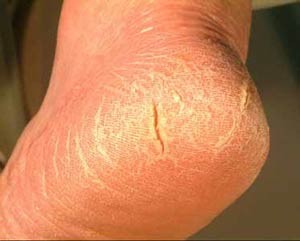Splits in the epidermis at the back of the heel are frequent, are uncomfortable, and do not look very good. This occurs if the fat pad beneath the heel stretches out sideways beneath the foot and the dried-out skin cracks or splits to create a heel fissure. A good way to understand them is to use the analogy of a tomato being compressed. As you apply force to the tomato to squash it, the skin of the tomato cracks as the insides pushes outwards. So it is with the heel. As bodyweight squashes the fat under the heel it expands out laterally from under the heel, it attempts to tear the epidermis around the perimeter of the heel. If this succeeds or not is going to depend on how flexible and strong that the skin is. If the skin is dry, thicker or callused, it is going to tear quickly. If the skin is thicker with a layer of callus, that skin will crack easily and place stress on the good skin below that will become very painful, even bleeding. Each step that is taken with even further open the crack which will help prevent it from healing. Cracked heels are more common in those who wear open heel type footwear, as a closed in shoe should help keep the fat pad under the heel in position and help prevent or reduce the effects of this.

The most efficient short term management of cracked heels is to have the callused skin removed by a podiatrist and then use strapping to hold the sides of the split together so that it can heal. The long term prevention of cracked skin around the heel should be apparent from the mechanism that was described above. To start with, weight reduction will help lessen the problem, but this is a long term issue. To help stop the fat pad under the heel from expanding out sideways and trying to split the skin, a closed in shoe needs to be worn and frequently the use of deep heel cup insoles can help. A foot doctor should be consulted on a regular basis to debride any dry callused skin. Emollients really should be applied regularly to keep the skin flexible so that it does not fissure. The use of pedicure files to maintain the callus under control could also be used.